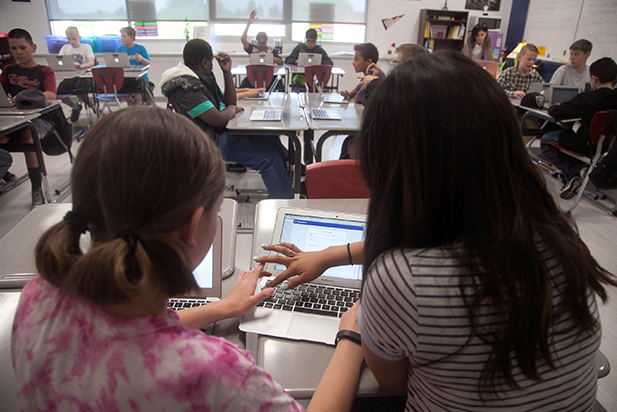
3 Ways Instructional Leaders Can Champion Technology in the Classroom
Do not launch your next blended initiative without trying these successful tactics.

Every project needs a champion. This rings true for initiatives launched in the workplace as well as the classroom. There are many ways a project champion can aid implementation, from acting as the strategic planner to taking on the role of cheerleader–plus everything in between. Without a champion, projects either never launch or they do so unsuccessfully, with everyone’s planning and preparation going to waste.
When it comes to implementing technology across a school or district, the role of the champion is all the more critical with thousands of dollars and children’s futures at stake. As with many educational initiatives, this job often (and should) falls upon instructional leaders who are in the position to mobilize and guide their teams.
At ThinkCERCA, we have had the opportunity to work alongside hundreds of districts and schools all with varying access to technology, blended learning initiatives, and needs. In working with these partners, we have stressed the following three tactics every instructional leader needs to follow in order to be a champion for technology in the classroom.
1. Clearly Communicate Strategic Goals
Your team is more likely to back an initiative if they understand its purpose and relevance to their day-to-day lives. Communications and marketing executive Georgia Everse recommends using the Inspire/Educate/Reinforce framework to communicate this effectively with your team.
- Inspire - Showcase how the blended initiative aligns with your district or school’s overall strategic vision. Most likely, this will mean clearly making the connection to student growth. Afterall, having an impact on students’ lives is why most of your team became educators in the first place. “Whether you’re looking to build optimism, change focus, instill curiosity, or prepare them for future decisions, you’ll have more impact if you stir some emotion and create a lasting memory.”
- Educate - Once you have inspired your team, it is time to educate them on their role in the process and the tools and data that will be provided to them during implementation. As Georgia points out, “It is most important for these messages to be delivered through dialogues rather than monologues, in smaller group sessions where employees can build to their own conclusions and feel ownership in how to implement.”
- Reinforce - Using a variety of tactics and channels, reinforce the initiative’s purpose and its connection to your overall mission throughout–and well beyond–implementation. This can be accomplished through meaningful dialogue, identifying project ambassadors who can help communicate to the team, and even storytelling. Once your initiative has launched look for pockets of success and share those stories with the entire team on a regular basis.
2. Look for Opportunities to Start Small
As we pointed out in our “Personalizing Literacy Through Blended Learning” administrator guide, blended initiatives can start small while you are getting your team up to speed and testing what works. You do not have to incorporate technology into everything at once. For example, find one course where you can add 10 to 15 minutes of technology instruction and build up from there.
3. Support Your Team Through Adequate Training & Support
If your team feels adequately supported, they will be more committed to the blended initiative. Provide multiple trainings on the adopted technology as well as best practices for implementing it in the classroom effectively. Additionally, consider grouping teachers together by varying technology readiness levels so they can learn from one another. In these groups, encourage sharing of successes and failures to develop schoolwide best practices for incorporating technology into the classroom.

Elizabeth Riley Boyer is an experienced journalist, digital content strategist, and operations manager. Prior to joining ThinkCERCA, she was part of the founding team at Impact Engine, Chicago’s first social impact investment fund and accelerator. As Impact Engine’s Director of Operations & Communications, Elizabeth oversaw the company’s overall processes, day-to-day planning and finances, curriculum development, marketing strategy, and community outreach.
Elizabeth also spent three years at Chicago magazine, most recently as its Digital Engagement Editor, where she managed the organization’s social media and reader engagement initiatives. Elizabeth also works as a freelance content strategist, writer, and communications consultant. Her recent writings on impact entrepreneurship have been featured by the Huffington Post and Crain’s Chicago Business.
In 2007, Elizabeth helped open a private school for underprivileged children while volunteering for a nonprofit organization in the Dominican Republic. This experience inspired her to quit a paper-pushing job at an insurance brokerage firm to pursue a master’s degree in journalism from Northwestern University. Elizabeth also holds a bachelor’s degree in American studies from the University of Texas at Austin.
